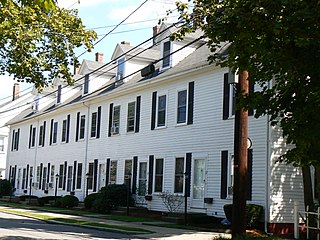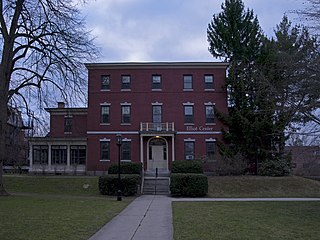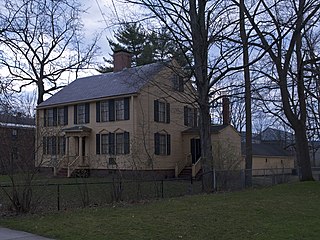
The Edmund Fowle House is a historic house and local history museum at 28 Marshall Street in Watertown, Massachusetts, USA. Built in 1772, it is the second-oldest surviving house in Watertown, and served as the meeting place for the Massachusetts Provincial Congress in the first year of the American Revolutionary War. Now owned by the local historic society, it was listed on the National Register of Historic Places in 1977.
The following properties are listed on the National Register of Historic Places in Arlington, Massachusetts.
This National Park Service list is complete through NPS recent listings posted June 14, 2024.

The Armory of the First Corps of Cadets is a historic armory at 97–105 Arlington Street and 130 Columbus Avenue in Boston, Massachusetts. Over the years it has been known as Park Plaza Castle, Castle at Park Plaza, and The Tower.

The Calvin Coolidge House is a historic house located at 19-21 Massasoit Street in Northampton, Massachusetts. Built in 1901, it is most historically significant as the home of the 30th president of the United States, Calvin Coolidge between 1906 and 1930, the height of his political career. It was listed on the National Register of Historic Places on December 12, 1976.

The Francis Wyman House is a historic house at 56 Francis Wyman Road in Burlington, Massachusetts.

The Baptist Society Meeting House is a historic former Baptist meeting house in Arlington, Massachusetts. Built in 1790, it is the town's oldest surviving church building. Now in residential use, the building was listed on the National Register of Historic Places in 1985.

The Cushman House is a historic house in Arlington, Massachusetts. Built in the mid-1880s and moved to its present location in 1896, it is a well-preserved but fully realized example of Queen Anne architecture. It was listed on the National Register of Historic Places in 1985.

The Ephraim Cutter House is a historic house at 4 Water Street in Arlington, Massachusetts. Built about 1804 by one of the town's leading mill owners, it is one of Arlington's few surviving Federal period houses. It was listed on the National Register of Historic Places in 1978, and included in an expansion of the Arlington Center Historic District in 1985.

The Addison Hill House is a historic house located in Arlington, Massachusetts.

The Orvis Road Historic District is a residential historic district in eastern Arlington, Massachusetts. Built as a planned development between 1918 and 1930, Orvis Road contains a well-preserved collection of single and double-family houses of the period, as well its distinctive landscaping, which includes a grassy median not found in Arlington's other planned subdivisions. The district was added to the National Register of Historic Places in 1985.

The Peirce Farm Historic District is a small historic district within the Arlington Heights neighborhood of the town of Arlington, Massachusetts. The district features three houses that are in a transitional style between Federal and Greek Revival styles, dating from the 1830s. The houses are located at 122 and 123 Claremont Avenue, and 178 Oakland Avenue. These three houses were all built by members of the Peirce family, who were among the earliest settlers of the Arlington Heights area, and owned much of its land into the late 19th century.

The Warren Rawson House is a historic row house at 37–49 Park Street in Arlington, Massachusetts. This utilitarian wood frame rowhouse was built c. 1885-90 by Warren Rawson, a leading farmer in Arlington, to house farm workers. It is one of only a few such multiunit buildings to survive in the town. The rowhouse was listed on the National Register of Historic Places in 1985.

The Taylor-Dallin House is a historic house in Arlington, Massachusetts. The house is notable as being the home of sculptor Cyrus E. Dallin (1861–1944) from 1899 until his death. It is a Colonial Revival/Shingle style 2+1⁄2-story wood-frame structure, with a hip roof studded with dormers, and a front porch supported by Tuscan columns. The house was built c. 1898 by Jack Taylor and sold to Dallin in 1899. Dallin's studio, no longer extant, stood in the rear of the property. Dallin was one of Arlington's most well-known citizens of the early 20th century, and his sculptures are found in several public settings around the town.

The George Wyman House is a historic house in Winchester, Massachusetts. The 2.5-story wood-frame house was built in the late 1820s, and is a rare local example of transitional Federal-Greek Revival styling. Basically Federal in its form, with side gable roof and five bay front, its center entry with full-length sidelights is more Greek Revival in character. The house was built by George Wyman near the site of one of the first houses to be built in what is now Winchester.

The Elliot Mansion is a historic house at 229 Main Street in Keene, New Hampshire. Built about 1810, it was said to be the finest house in town at the time of its completion, and it remains a high quality example of Federal period architecture. The house was listed on the National Register of Historic Places in 1976. It now houses facilities of Keene State College.

The Wyman Tavern is a historic house, former tavern, and now a local history museum, at 339 Main Street in Keene, New Hampshire. Built in 1762 by Isaac Wyman, it also served as the muster ground for militia at the outbreak of the American Revolutionary War. In 1968 the property was acquired by a local non-profit, which leases it to the Cheshire County Historical Society for use as a museum. The building was listed on the National Register of Historic Places in 1972.

The Rev. George Daman House is a historic house on Wyman Lane in Woodstock, Vermont, USA. Built in 1782 on the town's original 150-acre (61 ha) ministerial lot, it is a fine example of transitional Georgian/Federal styling in southeastern Vermont. It was listed on the National Register of Historic Places in 1989.
Wyman House may refer to:



















